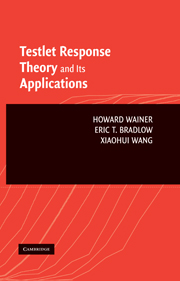Book contents
- Frontmatter
- Contents
- Preface
- PART I INTRODUCTION TO TESTLETS
- PART II BAYESIAN TESTLET RESPONSE THEORY
- PART III TWO APPLICATIONS AND A TUTORIAL
- 13 Using posterior distributions to evaluate passing scores: the PPoP curve
- 14 A Bayesian method for studying DIF: a cautionary tale filled with surprises and delights
- 15 A Bayesian primer
- Glossary of terms
- Epilogue
- Bibliography
- Author Index
- Subject Index
15 - A Bayesian primer
Published online by Cambridge University Press: 08 January 2010
- Frontmatter
- Contents
- Preface
- PART I INTRODUCTION TO TESTLETS
- PART II BAYESIAN TESTLET RESPONSE THEORY
- PART III TWO APPLICATIONS AND A TUTORIAL
- 13 Using posterior distributions to evaluate passing scores: the PPoP curve
- 14 A Bayesian method for studying DIF: a cautionary tale filled with surprises and delights
- 15 A Bayesian primer
- Glossary of terms
- Epilogue
- Bibliography
- Author Index
- Subject Index
Summary
Chapters 7 to 14 of this book have made heavy use of Bayesian ideas as well as the technology of Gibbs sampling that has made those ideas practical. In this chapter, we provide a modest tutorial on these methods to help get those unfamiliar with these methods “over the hump.” We do not pretend that this will provide a deep understanding for most previously naïve readers (for such an understanding we refer you to the usual sources, e.g., Gelman et al., 2003; Gilks, Richardson, & Spiegelhalter, 1995), but we do hope that this provides at least an outline of the methodology.
As part of both the good news and bad news associated with moving from true score theory–based inference (Chapter 2) to IRT-likelihood-based inference (Chapters 3–6) and finally Bayesian inference (Chapters 8–12) are the computational challenges that the researcher must face. Many of true score theory's results can be obtained by utilizing either standard analysis of variance routines (that estimates sources of variation yielding reliability estimates and the like) or factor analysis (that provides summary results on the covariation among the items); however, results under parametric IRT models require the fitting of models.
Moving beyond likelihood-based IRT to, for example, the approach taken in this book yields even greater computational challenges, as we append likelihood-based IRT models with prior distributions to yield posterior distributions as the quantities of interest, and subsequently Bayesian inference as the method of choice.
- Type
- Chapter
- Information
- Testlet Response Theory and Its Applications , pp. 234 - 246Publisher: Cambridge University PressPrint publication year: 2007



